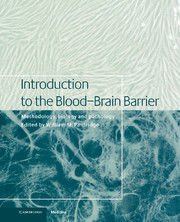Book contents
- Frontmatter
- Contents
- List of contributors
- 1 Blood–brain barrier methodology and biology
- Part I Methodology
- 2 The carotid artery single injection technique
- 3 Development of Brain Efflux Index (BEI) method and its application to the blood–brain barrier efflux transport study
- 4 In situ brain perfusion
- 5 Intravenous injection/pharmacokinetics
- 6 Isolated brain capillaries: an in vitro model of blood–brain barrier research
- 7 Isolation and behavior of plasma membrane vesicles made from cerebral capillary endothelial cells
- 8 Patch clamp techniques with isolated brain microvessel membranes
- 9 Tissue culture of brain endothelial cells – induction of blood–brain barrier properties by brain factors
- 10 Brain microvessel endothelial cell culture systems
- 11 Intracerebral microdialysis
- 12 Blood–brain barrier permeability measured with histochemistry
- 13 Measuring cerebral capillary permeability–surface area products by quantitative autoradiography
- 14 Measurement of blood–brain barrier in humans using indicator diffusion
- 15 Measurement of blood–brain permeability in humans with positron emission tomography
- 16 Magnetic resonance imaging of blood–brain barrier permeability
- 17 Molecular biology of brain capillaries
- Part II Transport biology
- Part III General aspects of CNS transport
- Part IV Signal transduction/biochemical aspects
- Part V Pathophysiology in disease states
- Index
3 - Development of Brain Efflux Index (BEI) method and its application to the blood–brain barrier efflux transport study
from Part I - Methodology
Published online by Cambridge University Press: 10 December 2009
- Frontmatter
- Contents
- List of contributors
- 1 Blood–brain barrier methodology and biology
- Part I Methodology
- 2 The carotid artery single injection technique
- 3 Development of Brain Efflux Index (BEI) method and its application to the blood–brain barrier efflux transport study
- 4 In situ brain perfusion
- 5 Intravenous injection/pharmacokinetics
- 6 Isolated brain capillaries: an in vitro model of blood–brain barrier research
- 7 Isolation and behavior of plasma membrane vesicles made from cerebral capillary endothelial cells
- 8 Patch clamp techniques with isolated brain microvessel membranes
- 9 Tissue culture of brain endothelial cells – induction of blood–brain barrier properties by brain factors
- 10 Brain microvessel endothelial cell culture systems
- 11 Intracerebral microdialysis
- 12 Blood–brain barrier permeability measured with histochemistry
- 13 Measuring cerebral capillary permeability–surface area products by quantitative autoradiography
- 14 Measurement of blood–brain barrier in humans using indicator diffusion
- 15 Measurement of blood–brain permeability in humans with positron emission tomography
- 16 Magnetic resonance imaging of blood–brain barrier permeability
- 17 Molecular biology of brain capillaries
- Part II Transport biology
- Part III General aspects of CNS transport
- Part IV Signal transduction/biochemical aspects
- Part V Pathophysiology in disease states
- Index
Summary
Introduction
Brain interstitial fluid concentration of drugs and/or nutrients, a significantly important value for the central nervous system (CNS) effects and/or the cerebral functions, is believed to be mainly governed by the net flux between the brain interstitial fluid and the circulating blood in the brain capillaries across the blood–brain barrier (BBB). Although several influx transport systems at the BBB have been characterized (Pardridge and Oldendorf, 1977; Pardridge, 1983; Smith et al., 1987; Terasaki et al., 1991), only a limited amount of information appears to be available on the transport process from the brain interstitial fluid to the circulating blood at the BBB (Betz and Goldstein, 1978; Oldendorf et al., 1982; Barrera et al., 1991; Banks et al., 1993), i.e. the BBB efflux transport process. For an understanding of the physiological function of the BBB, presumably as a regulating machinery of brain interstitial fluid constituents balance including nutrients, neurotransmitters and its metabolites, it is significantly important to clarify the efflux transport process across the BBB. Moreover, it would also be helpful for the development of the CNS-acting drugs to characterize the drug efflux transport process from the brain, while most studies have been focused on the influx process from the circulating blood to the brain. The purpose of this chapter is to describe the Brain Efflux Index (BEI) method, a newly developed method to determine the in vivo efflux transport clearance across the BBB (Kakee et al., 1996).
- Type
- Chapter
- Information
- Introduction to the Blood-Brain BarrierMethodology, Biology and Pathology, pp. 24 - 31Publisher: Cambridge University PressPrint publication year: 1998
- 3
- Cited by



